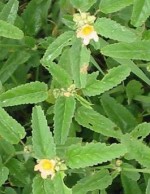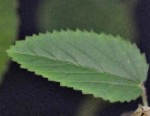 The origins of prickly sida are obscure but the general feeling is that the plant is a native of tropical America. It has spread to many semi-tropical and tropical areas including the United States and is found in the eastern half of the country as well as in some areas of the West Coast. It grows well in sites with full or partial sun and moist to medium dry, loamy fertile soil and is a weed of disturbed sites such as cropland, gardens, abandoned fields, and pastures, as well as along railroad tracks and roadsides. It causes particular problems in the production of soybean, peanuts and corn in the southern states.
The origins of prickly sida are obscure but the general feeling is that the plant is a native of tropical America. It has spread to many semi-tropical and tropical areas including the United States and is found in the eastern half of the country as well as in some areas of the West Coast. It grows well in sites with full or partial sun and moist to medium dry, loamy fertile soil and is a weed of disturbed sites such as cropland, gardens, abandoned fields, and pastures, as well as along railroad tracks and roadsides. It causes particular problems in the production of soybean, peanuts and corn in the southern states.
 Decription: The seedlings of this summer annual emerge in late spring when the soil is warm and have two heart-shaped hairy
Decription: The seedlings of this summer annual emerge in late spring when the soil is warm and have two heart-shaped hairy
cotyledons followed  by the first true leaves that are one inch long by ½ inch wide and have evenly toothed margins. Erect, branched stems bearing hairs support alternately arranged leaves up to two inches long and with toothed margins. The petioles of the leaves are ½ to 1¼ inches long and may have a small spine at their base. In mid-summer to early fall light yellow to orange flowers are produced singly or in clusters on stems arising from the
by the first true leaves that are one inch long by ½ inch wide and have evenly toothed margins. Erect, branched stems bearing hairs support alternately arranged leaves up to two inches long and with toothed margins. The petioles of the leaves are ½ to 1¼ inches long and may have a small spine at their base. In mid-summer to early fall light yellow to orange flowers are produced singly or in clusters on stems arising from the
axils of the leaves. Each flower has five petals and is about 1/3 inch across. The flowers open during bright sunny mornings but may be somewhat hidden by the surrounding leaves. The round seedpods that follow contain five reddish brown seeds that bear two distinctive stiff spines at their tip, accounting for the name of the plant. The seeds can remain viable in the soil for several years. The root system consists of a shallow taproot with fibrous secondary roots.

 Control: Hand pulling, hoeing and mulching when warm weather arrives keeps this weed from becoming a problem. Where infestations are heavy, mowing can be effective in eliminating flowers before they set seed. Low mowing can reduce the number of plants permanently since many of them will not be able to recover.
Control: Hand pulling, hoeing and mulching when warm weather arrives keeps this weed from becoming a problem. Where infestations are heavy, mowing can be effective in eliminating flowers before they set seed. Low mowing can reduce the number of plants permanently since many of them will not be able to recover.